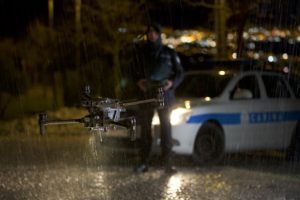
Sember has been a firefighter in the Boca Raton area for over 17 years. He began flying drones recreationally, traveling all over the world to capture aerial images.
“Using the drone for search and rescue missions is a game changer,” says Sember. “Drones are useful anywhere.”
The Evolving Benefits of Drone in Search and Rescue
Traditionally search and rescue (SAR) operations have relied upon human personnel. Drones have been recognized as a valuable tool in SAR missions from the beginning of the commercial industry. As aircraft and sensors have improved, however, the benefits of drones in search and rescue have evolved and improved also.
Drones can make a SAR mission more effective and efficient when they are integrated into regular operations. In addition to speed and efficiency, drones can access difficult terrain and, Sember says, get in the air in less than a minute – much faster than a team on foot can get on location.
Real Time Data Streaming and Mapping
Real time data streaming and real time mapping software has developed to provide search and rescue missions with critical situational awareness during operations. Sember points out that mapping technology can help teams get in, and help commanders determine the best routes out for search and rescue operations in the wilderness.
Improved Sensors and Features
Most drones come equipped with GPS technology. Sember says GPS is underutilized in SAR operations, and is an excellent tool for precisely locating a subject to direct ground teams.
While the ground team reaches the subject, drone operators can use zoom cameras, which have developed significantly in the last few years, to evaluate the condition of the subject and their surroundings. Medical kits can be delivered by drone for immediate relief while ground crews work to reach a subject. Thermal imaging has also improved significantly, providing a valuable tool for nighttime missions. Sensors like speakers and lights also provide major benefit to operators.
New drone flight automation features have also helped to make SAR operations easier. Programming an aircraft to fly in a pattern to cover an area, or using waypoints to determine a flight path, ensures efficient coverage. “It takes the stress off of the pilot,” says Sember. “You send it on its pattern and let it go.”
More Places, More Conditions
Overall, says Sember, drones have gotten more weather resilient and more rugged. That means that search and rescue operators can integrate drones into more missions, in a broader range of weather conditions and environments. Sember points out that drones are useful in a wide variety of situations, and aren’t limited to rural and wilderness situations. “In an urban setting, the benefits are even greater,” says Sember. “You can just get to the search location so much faster.”
Read more:
- The Future of Drones for Search and Rescue: from the Floor of National Public Safety UAS Conference
- Garuda Aerospace Drones Deployed in Turkey for Search and Rescue, Relief Efforts
- Japan’s Night Hawks Fly Drone Search and Rescue Missions After Dark in Nishikawa
- Lifeseeker Mini, Search and Rescue Drone Wins AUVSI Xcellence Award
Miriam McNabb is the Editor-in-Chief of DRONELIFE and CEO of JobForDrones, a professional drone services marketplace, and a fascinated observer of the emerging drone industry and the regulatory environment for drones. Miriam has penned over 3,000 articles focused on the commercial drone space and is an international speaker and recognized figure in the industry. Miriam has a degree from the University of Chicago and over 20 years of experience in high tech sales and marketing for new technologies.
For drone industry consulting or writing, Email Miriam.
TWITTER:@spaldingbarker
Subscribe to DroneLife here.